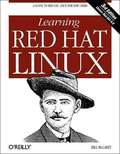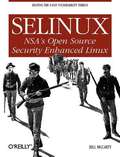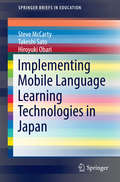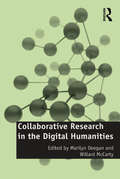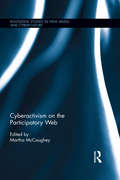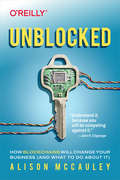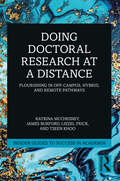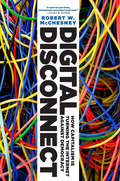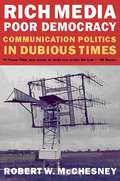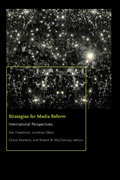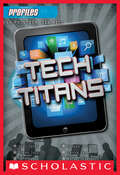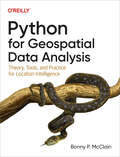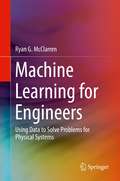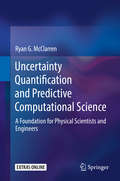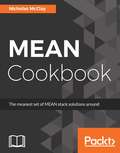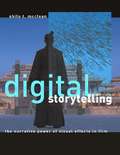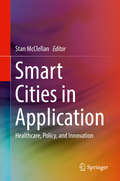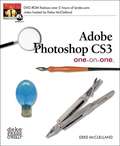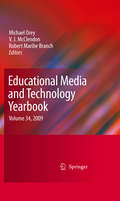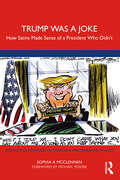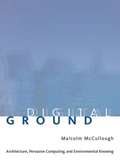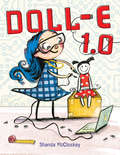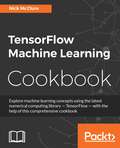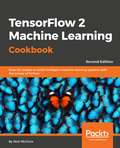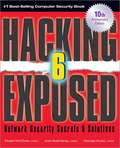- Table View
- List View
Learning Red Hat Linux, 3rd Edition
by Bill MccartyThe third edition of Learning Red Hat Linuxguides you through the process of installing and running Red Hat Linux on your PC. Written in a friendly, easy-to-understand style, this book contains all you need to get started . With new tutorials covering OpenOffice Tools and the desktop, this book is excellent for first-time Linux users who want to install the operating system on a new PC or convert an existing system to Linux.
SELinux
by Bill MccartyThe intensive search for a more secure operating system has often left everyday, production computers far behind their experimental, research cousins. Now SELinux (Security Enhanced Linux) dramatically changes this. This best-known and most respected security-related extension to Linux embodies the key advances of the security field. Better yet, SELinux is available in widespread and popular distributions of the Linux operating system--including for Debian, Fedora, Gentoo, Red Hat Enterprise Linux, and SUSE--all of it free and open source. SELinux emerged from research by the National Security Agency and implements classic strong-security measures such as role-based access controls, mandatory access controls, and fine-grained transitions and privilege escalation following the principle of least privilege. It compensates for the inevitable buffer overflows and other weaknesses in applications by isolating them and preventing flaws in one application from spreading to others. The scenarios that cause the most cyber-damage these days--when someone gets a toe-hold on a computer through a vulnerability in a local networked application, such as a Web server, and parlays that toe-hold into pervasive control over the computer system--are prevented on a properly administered SELinux system. The key, of course, lies in the words "properly administered." A system administrator for SELinux needs a wide range of knowledge, such as the principles behind the system, how to assign different privileges to different groups of users, how to change policies to accommodate new software, and how to log and track what is going on. And this is where SELinux is invaluable. Author Bill McCarty, a security consultant who has briefed numerous government agencies, incorporates his intensive research into SELinux into this small but information-packed book. Topics include: A readable and concrete explanation of SELinux concepts and the SELinux security model Installation instructions for numerous distributions Basic system and user administration A detailed dissection of the SELinux policy language Examples and guidelines for altering and adding policies With SELinux , a high-security computer is within reach of any system administrator. If you want an effective means of securing your Linux system--and who doesn't?--this book provides the means.
Implementing Mobile Language Learning Technologies in Japan
by Steve Mccarty Hiroyuki Obari Takeshi SatoThis book explores theoretical and practical aspects of implementing mobile language learning in university classrooms for English as a Foreign Language in Japan. The technologies utilized, such as smartphones, iPads, and wi-fi, integrate students' hand-held devices into the campus network infrastructure. The pedagogical aims of ubiquitous mobile learning further incorporate social media, blended learning, and flipped classroom approaches into the curriculum. Chapter 1 defines mobile language learning within dimensions of e-learning and technology-assisted language learning, prior to tracing the development of mobile learning in Japan. Chapter 2 documents the sociocultural theory underpinning the authors' humanistic approach to implementation of mobile technologies. The sociocultural pedagogy represents a global consensus of leading educators that also recognizes the agency of Asian learners and brings out their capability for autonomous learning. Case studies of universities, large and small, public and private, are organized similarly in Chapters 3 to 5. Institutional/pedagogical and technological context sections are followed by detailed content on the implementation of initiatives, assessment of effectiveness, and recommendations for other institutions. Distinct from a collection of papers, this monograph tells a story in brief book length about theorizing and realizing mobile language learning, describing pioneering and original initiatives of importance to practitioners in other educational contexts.
Collaborative Research in the Digital Humanities (Digital Research in the Arts and Humanities)
by Willard McCarty Marilyn DeeganCollaboration within digital humanities is both a pertinent and a pressing topic as the traditional mode of the humanist, working alone in his or her study, is supplemented by explicitly co-operative, interdependent and collaborative research. This is particularly true where computational methods are employed in large-scale digital humanities projects. This book, which celebrates the contributions of Harold Short to this field, presents fourteen essays by leading authors in the digital humanities. It addresses several issues of collaboration, from the multiple perspectives of institutions, projects and individual researchers.
Cyberactivism on the Participatory Web (Routledge Studies in New Media and Cyberculture)
by Martha McCaugheyCyberactivism already has a rich history, but over the past decade the participatory web—with its de-centralized information/media sharing, portability, storage capacity, and user-generated content—has reshaped political and social change. Cyberactivism on the Participatory Web examines the impact of these new technologies on political organizing and protest across the political spectrum, from the Arab Spring to artists to far-right groups. Linking new information and communication technologies to possibilities for solidarity and action—as well as surveillance and control—in a context of global capital flow, war, and environmental crisis, the contributors to this volume provide nuanced analyses of the dramatic transformations in media, citizenship, and social movements taking place today.
Unblocked: How Blockchains Will Change Your Business (and What to Do About It)
by Alison McCauleyRemember the dawn of the internet or the advent of mobile computing and social media? Yet another digital revolution is now underway. Like its predecessors, blockchains are about to transform the way we live, work, and play, while disrupting entrenched industries and shattering conventional business models.This practical guide takes you past the hype to show you exactly what blockchains do and how they’re poised to change our world. Author Alison McCauley explains how blockchains provide an open, distributed ledger for recording transactions in a verifiable and permanent way. You will learn how this technology provides an abundance of opportunity for those who know how to leverage blockchains to address privacy risks, hacks, data misuse, and fraud.Unblocked explains:Why ignoring this technology exposes you to competitive disruptionWhat this new technology revolution embraces—no technical background requiredHow to prepare your organization to respond to the coming shift
Doing Doctoral Research at a Distance: Flourishing In Off-Campus, Hybrid, and Remote Pathways (Insider Guides to Success in Academia)
by Katrina McChesney James Burford Liezel Frick Tseen KhooEmerging from personal experience and empirical research, Doing Doctoral Research at a Distance is a key companion text for doctoral students from a range of research fields and geographical contexts who are undertaking off-campus, hybrid, and remote pathways. Offering guidance about the entire off-campus doctoral journey, the book introduces contexts of distance study; key information to get off to a flying start; organising time, space and plans to get work done; juggling employment, family and other commitments alongside distance study; doctoral identity and wellbeing; working with doctoral supervisors at a distance; accessing research culture at a distance; and managing the bumps along the road of the distance doctorate. Written for doctoral researchers, this book offers strategies to help those working at a distance to flourish. This book is ideally suited for those contemplating distance study, distance doctoral students who are starting their off-campus journey, and supervisors and others who are working with distance doctoral researchers.‘Insider Guides to Success in Academia’ offers support and practical advice to doctoral students and early-career researchers. Covering the topics that really matter, but which often get overlooked, this indispensable series provides practical and realistic guidance to address many of the needs and challenges of trying to operate, and remain, in academia. These neat pocket guides fill specific and significant gaps in current literature. Each book offers insider perspectives on the often implicit rules of the game – the things you need to know but usually aren’t told by institutional postgraduate support, researcher development units, or supervisors – and will address a practical topic that is key to career progression. They are essential reading for doctoral students, earlycareer researchers, supervisors, mentors, or anyone looking to launch or maintain their career in academia.
Digital Disconnect
by Robert W. McchesneyCelebrants and skeptics alike have produced valuable analyses of the Internet's effect on us and our world, oscillating between utopian bliss and dystopian hell. But according to Robert W. McChesney, arguments on both sides fail to address the relationship between economic power and the digital world.McChesney's award-winning Rich Media, Poor Democracy skewered the assumption that a society drenched in commercial information is a democratic one. In Digital Disconnect McChesney returns to this provocative thesis in light of the advances of the digital age, incorporating capitalism into the heart of his analysis. He argues that the sharp decline in the enforcement of antitrust violations, the increase in patents on digital technology and proprietary systems, and other policies and massive indirect subsidies have made the Internet a place of numbing commercialism. A small handful of monopolies now dominate the political economy, from Google, which garners an astonishing 97 percent share of the mobile search market, to Microsoft, whose operating system is used by over 90 percent of the world's computers. This capitalistic colonization of the Internet has spurred the collapse of credible journalism, and made the Internet an unparalleled apparatus for government and corporate surveillance, and a disturbingly anti-democratic force.In Digital Disconnect Robert McChesney offers a groundbreaking analysis and critique of the Internet, urging us to reclaim the democratizing potential of the digital revolution while we still can.
Rich Media, Poor Democracy: Communication Politics in Dubious Times
by Robert W. McchesneyIn this myth-breaking book, McChesney argues that the media, far from providing a bedrock for freedom and democracy, have become a significant anti-democratic force in the United States and, to varying degrees, worldwide.
Strategies for Media Reform: International Perspectives
by Robert W. Mcchesney Jonathan A. Obar Des Freedman Cheryl MartensMedia reform plays an increasingly important role in the struggle for social justice. As battles are fought over the future of investigative journalism, media ownership, spectrum management, speech rights, broadband access, network neutrality, the surveillance apparatus, and digital literacy, what effective strategies can be used in the pursuit of effective media reform? Prepared by thirty-three scholars and activists from more than twenty-five countries, Strategies for Media Reform focuses on theorizing media democratization and evaluating specific projects for media reform. This edited collection of articles offers readers the opportunity to reflect on the prospects for and challenges facing campaigns for media reform and gathers significant examples of theory, advocacy, and activism from multinational perspectives.
Profiles #3: Tech Titans (Profiles #3)
by Carla Killough McclaffertyFull-color series-six bios in one! It takes more than one person to bring about change and innovation. Explore the lives of the people who have had a huge impact on technology today. So much more than just your typical biography, PROFILES: TECH TITANS focuses on six of the most prominent figures in the technological world. This book includes all of the biographical information kids need to know (background, family, education, accomplishments, etc.) about Bill Gates, Steve Jobs, Mark Zuckerberg, Larry Page, Sergey Brin, and Jeff Bezos--the men behind Windows, Apple, Facebook, Google, and Amazon! Photographs and quotes will be interwoven throughout the text.
Python for Geospatial Data Analysis
by Bonny P. McClainIn spatial data science, things in closer proximity to one another likely have more in common than things that are farther apart. With this practical book, geospatial professionals, data scientists, business analysts, geographers, geologists, and others familiar with data analysis and visualization will learn the fundamentals of spatial data analysis to gain a deeper understanding of their data questions.Author Bonny P. McClain demonstrates why detecting and quantifying patterns in geospatial data is vital. Both proprietary and open source platforms allow you to process and visualize spatial information. This book is for people familiar with data analysis or visualization who are eager to explore geospatial integration with Python.This book helps you:Understand the importance of applying spatial relationships in data scienceSelect and apply data layering of both raster and vector graphicsApply location data to leverage spatial analyticsDesign informative and accurate mapsAutomate geographic data with Python scriptsExplore Python packages for additional functionalityWork with atypical data types such as polygons, shape files, and projectionsUnderstand the graphical syntax of spatial data science to stimulate curiosity
Machine Learning for Engineers: Using data to solve problems for physical systems
by Ryan G. McClarrenAll engineers and applied scientists will need to harness the power of machine learning to solve the highly complex and data intensive problems now emerging. This text teaches state-of-the-art machine learning technologies to students and practicing engineers from the traditionally “analog” disciplines—mechanical, aerospace, chemical, nuclear, and civil. Dr. McClarren examines these technologies from an engineering perspective and illustrates their specific value to engineers by presenting concrete examples based on physical systems. The book proceeds from basic learning models to deep neural networks, gradually increasing readers’ ability to apply modern machine learning techniques to their current work and to prepare them for future, as yet unknown, problems. Rather than taking a black box approach, the author teaches a broad range of techniques while conveying the kinds of problems best addressed by each. Examples and case studies in controls, dynamics, heat transfer, and other engineering applications are implemented in Python and the libraries scikit-learn and tensorflow, demonstrating how readers can apply the most up-to-date methods to their own problems. The book equally benefits undergraduate engineering students who wish to acquire the skills required by future employers, and practicing engineers who wish to expand and update their problem-solving toolkit.
Uncertainty Quantification and Predictive Computational Science: A Foundation for Physical Scientists and Engineers
by Ryan G. McClarrenThis textbook teaches the essential background and skills for understanding and quantifying uncertainties in a computational simulation, and for predicting the behavior of a system under those uncertainties. It addresses a critical knowledge gap in the widespread adoption of simulation in high-consequence decision-making throughout the engineering and physical sciences. Constructing sophisticated techniques for prediction from basic building blocks, the book first reviews the fundamentals that underpin later topics of the book including probability, sampling, and Bayesian statistics. Part II focuses on applying Local Sensitivity Analysis to apportion uncertainty in the model outputs to sources of uncertainty in its inputs. Part III demonstrates techniques for quantifying the impact of parametric uncertainties on a problem, specifically how input uncertainties affect outputs. The final section covers techniques for applying uncertainty quantification to make predictions under uncertainty, including treatment of epistemic uncertainties. It presents the theory and practice of predicting the behavior of a system based on the aggregation of data from simulation, theory, and experiment. The text focuses on simulations based on the solution of systems of partial differential equations and includes in-depth coverage of Monte Carlo methods, basic design of computer experiments, as well as regularized statistical techniques. Code references, in python, appear throughout the text and online as executable code, enabling readers to perform the analysis under discussion. Worked examples from realistic, model problems help readers understand the mechanics of applying the methods. Each chapter ends with several assignable problems. Uncertainty Quantification and Predictive Computational Science fills the growing need for a classroom text for senior undergraduate and early-career graduate students in the engineering and physical sciences and supports independent study by researchers and professionals who must include uncertainty quantification and predictive science in the simulations they develop and/or perform.
MEAN Cookbook
by Nicholas McclayOver 50 recipes to create full-stack high-performance web applications using pure JavaScript and the MEAN stack. About This Book • Architect a fully functional stand-alone web application, including the web server, database, and front-end web application • Improve the performance and maintainability of your MEAN stack application with tips for configuration and optimization • Highlights MEAN Stack best practices when working with your application Who This Book Is For If you are a JavaScript developer who wants to create high-performing, modern web applications with the MEAN stack, this is the book for you. Web developers familiar with some parts of the MEAN stack will find this a comprehensive guide to fleshing out the other technologies and skills they need to build all JavaScript web applications. Developers interested in transitioning from other web application stacks to an all-JavaScript environment will find a wealth of information about how to work in a MEAN stack environment. To get the most from this book, you should have a general understanding of web servers and web applications. You are expected to have a basic understanding of running JavaScript, both in a web browser and outside it, using Node.js and the NPM package manager. What You Will Learn • Bootstrap a new MEAN stack web application using Node.js and Express • Build a single-page application (SPA) with Angular and Angular-CLI • Improve browser performance by optimizing your web application resources using Webpack • Model complex JSON object relationships in MongoDB using Mongoose • Debug all the layers of a MEAN stack application, including working with source maps • Build Restful APIs using Express.js and JSON Web Token (JWT) for user authentication • Use automated testing to improve the reliability and quality of your MEAN stack application In Detail The MEAN Stack is a framework for web application development using JavaScript-based technologies; MongoDB, Express, Angular, and Node.js. If you want to expand your understanding of using JavaScript to produce a fully functional standalone web application, including the web server, user interface, and database, then this book can help guide you through that transition. This book begins by configuring the frontend of the MEAN stack web application using the Angular JavaScript framework. We then implement common user interface enhancements before moving on to configuring the server layer of our MEAN stack web application using Express for our backend APIs. You will learn to configure the database layer of your MEAN stack web application using MongoDB and the Mongoose framework, including modeling relationships between documents. You will explore advanced topics such as optimizing your web application using WebPack as well as the use of automated testing with the Mocha and Chai frameworks. By the end of the book, you should have acquired a level of proficiency that allows you to confidently build a full production-ready and scalable MEAN stack application. Style and Approach This book is a guide of MEAN Stack specific solutions to common web application problems and includes in-depth guides for each layer of the application stack. Readers looking to upgrade their MEAN Stack web application will find recipes within to help them transition.
Digital Storytelling
by Shilo T. MccleanComputer-generated effects are often blamed for bad Hollywood movies. Yet when a critic complains that "technology swamps storytelling" (in a review of Van Helsing, calling it "an example of everything that is wrong with Hollywood computer-generated effects movies"), it says more about the weakness of the story than the strength of the technology. In Digital Storytelling, Shilo McClean shows how digital visual effects can be a tool of storytelling in film, adding narrative power as do sound, color, and "experimental" camera angles--other innovative film technologies that were once criticized for being distractions from the story. It is time, she says, to rethink the function of digital visual effects. Effects artists say--contrary to the critics--that effects always derive from story. Digital effects are a part of production, not post-production; they are becoming part of the story development process. Digital Storytelling is grounded in filmmaking, the scriptwriting process in particular. McClean considers crucial questions about digital visual effects-- whether they undermine classical storytelling structure, if they always call attention to themselves, whether their use is limited to certain genres--and looks at contemporary films (including a chapter-long analysis of Steven Spielberg's use of computer-generated effects) and contemporary film theory to find the answers. McClean argues that to consider digital visual effects as simply contributing the "wow" factor underestimates them. They are, she writes, the legitimate inheritors of film storycraft.
Smart Cities in Application: Healthcare, Policy, and Innovation
by Stan McClellanThis book explores categories of applications and driving factors surrounding the Smart City phenomenon. The contributing authors provide perspective on the Smart Cities, covering numerous applications and classes of applications. The book uses a top-down exploration of the driving factors in Smart Cities, by including focal areas including “Smart Healthcare,” “Public Safety & Policy Issues,” and “Science, Technology, & Innovation.” Contributors have direct and substantive experience with important aspects of Smart Cities and discuss issues with technologies & standards, roadblocks to implementation, innovations that create new opportunities, and other factors relevant to emerging Smart City infrastructures.Features an exploration of Smart City issues and solutions from a variety of stakeholders in the evolving fieldPresents conversational, nuanced, and forward thinking perspectives on Smart Cities, their implications, limitations, obstacles, and opportunitiesIncludes contributions from industry insiders who have direct, relevant experience with their respective subjects as well as positioning and corporate stature
Adobe Photoshop CS3 One-on-One
by Deke McclellandPioneering computer graphics author Deke McClelland updates his bestselling hands-on tutorial for Adobe Photoshop CS3, the latest version of this industry-standard image editing and production program. As with previous editions, Photoshop CS3 One-on-One guides readers step by step through the program's features and functionality. A key appeal of the One-on-One series is the two hours of DVD-video material included. Once you read about a particular technique, you can see how it's done first hand in the video. The combination is uniquely effective. And hugely popular. Whether you're a first-timer looking to learn Photoshop, or a seasoned user interested in the groundbreaking features of CS3, Deke's conversational style and carefully structured lessons guide you through everything you need to know to get up and running, and then takes you well into mastery. You'll learn to: Grasp fundamental and advanced concepts and theory Use best practices, and techniques for making the most of Photoshop CS3 Build relevant, real-world projects Use Photoshop's workflow and file handling features Use the combined power of Bridge + Camera Raw to process your digital photos Choose the right technique for converting your images to black & white Create beautiful multilayered documents including posters and flyers And much more A Photoshop expert, sought-after computer graphics and design lecturer and author of over 70 books, Deke creates a classroom environment in Photoshop CS3 One-on-One with written instruction and video training -- except that you get one-on-one attention as you proceed from lesson to lesson at your own pace. It's like having private lessons with the author. Whether you're an enthusiast, prosumer, creative pro, technical pro, or newcomer, Deke's book will have you speaking fluent Photoshop CS3 in no time.
Educational Media and Technology Yearbook, Volume 34
by V. J. Mcclendon Robert Maribe Branch Michael OreyThe Educational Media and Technology Yearbook is dedicated to theoretical, empirical and practical approaches to educational media development. All chapters are invited and selected based on a variety of strategies to determine current trends and issues in the field. The 2009 edition will highlight innovative Trends and Issues in Learning Design and Technology, Trends and Issues in Information and Library Science, and features a section that lists and describes Media Related Organizations and Associations in North America. <P><P> The Educational Media and Technology Yearbook, a scholarly resource for a highly specialized professional community, is an official publication of the AECT and has been published annually for 33 years.
Trump Was a Joke: How Satire Made Sense of a President Who Didn’t (Routledge Advances in Theatre & Performance Studies)
by Sophia A McclennenWritten by a scholar of satire and politics, Trump Was a Joke explains why satire is an exceptional foil for absurd political times and why it did a particularly good job of making sense of Trump. Covering a range of comedic interventions, Trump Was a Joke analyzes why political satire is surprisingly effective at keeping us sane when politics is making us crazy. Its goal is to highlight the unique power of political satire to encourage critical thinking, foster civic action, and further rational debate in moments of political hubris and hysteria. The book has been endorsed by Bassem Youssef, who has been referred to as the “Jon Stewart of Egypt,” and Srdja Popovic, author of Blueprint for Revolution, who used satirical activism to bring down Serbian dictator Slobodan Milosevic. With a foreword by award-winning filmmaker, satirist, and activist Michael Moore, this study will be of interest to readers who follow politics and enjoy political comedy and will appeal to the communications, comedy studies, media studies, political science, rhetoric, cultural studies, and American studies markets.
Digital Ground: Architecture, Pervasive Computing, and Environmental Knowing
by Malcom McclloughDigital Ground is an architect's response to the design challenge posed by pervasive computing. One century into the electronic age, people have become accustomed to interacting indirectly, mediated through networks.
Doll-E 1.0
by Shanda McCloskeyA STEM-friendly tale of a girl and the doll she upgrades to be her new friend, for fans of The Most Magnificent Thing and Rosie Revere, Engineer.Charlotte's world is fully charged! With her dog at her side, she's always tinkering, coding, clicking, and downloading. She's got a knack for anything technological--especially gadgets that her parents don't know how to fix! Then, she receives a new toy that is quite a puzzle: a doll! What's she supposed to do with that? Once she discovers the doll's hidden battery pack, things start to get interesting...while her faithful canine sidekick wonders if he'll be overshadowed by the new and improved Doll-E 1.0! With a little ingenuity and an open mind, everyone can be friends in this endearing, modern tribute to the creative spirit of play.
TensorFlow Machine Learning Cookbook
by Nick McclureExplore machine learning concepts using the latest numerical computing library — TensorFlow — with the help of this comprehensive cookbook About This Book • Your quick guide to implementing TensorFlow in your day-to-day machine learning activities • Learn advanced techniques that bring more accuracy and speed to machine learning • Upgrade your knowledge to the second generation of machine learning with this guide on TensorFlow Who This Book Is For This book is ideal for data scientists who are familiar with C++ or Python and perform machine learning activities on a day-to-day basis. Intermediate and advanced machine learning implementers who need a quick guide they can easily navigate will find it useful. What You Will Learn • Become familiar with the basics of the TensorFlow machine learning library • Get to know Linear Regression techniques with TensorFlow • Learn SVMs with hands-on recipes • Implement neural networks and improve predictions • Apply NLP and sentiment analysis to your data • Master CNN and RNN through practical recipes • Take TensorFlow into production In Detail TensorFlow is an open source software library for Machine Intelligence. The independent recipes in this book will teach you how to use TensorFlow for complex data computations and will let you dig deeper and gain more insights into your data than ever before. You'll work through recipes on training models, model evaluation, sentiment analysis, regression analysis, clustering analysis, artificial neural networks, and deep learning – each using Google's machine learning library TensorFlow. This guide starts with the fundamentals of the TensorFlow library which includes variables, matrices, and various data sources. Moving ahead, you will get hands-on experience with Linear Regression techniques with TensorFlow. The next chapters cover important high-level concepts such as neural networks, CNN, RNN, and NLP. Once you are familiar and comfortable with the TensorFlow ecosystem, the last chapter will show you how to take it to production. Style and approach This book takes a recipe-based approach where every topic is explicated with the help of a real-world example.
TensorFlow Machine Learning Cookbook: Over 60 recipes to build intelligent machine learning systems with the power of Python, 2nd Edition
by Nick McClureSkip the theory and get the most out of Tensorflow to build production-ready machine learning modelsKey FeaturesExploit the features of Tensorflow to build and deploy machine learning modelsTrain neural networks to tackle real-world problems in Computer Vision and NLPHandy techniques to write production-ready code for your Tensorflow modelsBook DescriptionTensorFlow is an open source software library for Machine Intelligence. The independent recipes in this book will teach you how to use TensorFlow for complex data computations and allow you to dig deeper and gain more insights into your data than ever before. With the help of this book, you will work with recipes for training models, model evaluation, sentiment analysis, regression analysis, clustering analysis, artificial neural networks, and more. You will explore RNNs, CNNs, GANs, reinforcement learning, and capsule networks, each using Google's machine learning library, TensorFlow. Through real-world examples, you will get hands-on experience with linear regression techniques with TensorFlow. Once you are familiar and comfortable with the TensorFlow ecosystem, you will be shown how to take it to production.By the end of the book, you will be proficient in the field of machine intelligence using TensorFlow. You will also have good insight into deep learning and be capable of implementing machine learning algorithms in real-world scenarios.What you will learnBecome familiar with the basic features of the TensorFlow libraryGet to know Linear Regression techniques with TensorFlowLearn SVMs with hands-on recipesImplement neural networks to improve predictive modelingApply NLP and sentiment analysis to your dataMaster CNN and RNN through practical recipesImplement the gradient boosted random forest to predict housing pricesTake TensorFlow into productionWho this book is forIf you are a data scientist or a machine learning engineer with some knowledge of linear algebra, statistics, and machine learning, this book is for you. If you want to skip the theory and build production-ready machine learning models using Tensorflow without reading pages and pages of material, this book is for you. Some background in Python programming is assumed.
Hacking Exposed: Network Security Secrets and Solutions (6th Edition)
by Stuart Mcclure Joel Scambray George KurtzMeet the formidable demands of security in today's hyperconnected world with expert guidance from the world-renowned Hacking Exposed team. Following the time-tested "attack-countermeasure" philosophy, this 10th anniversary edition has been fully overhauled to cover the latest insidious weapons in the hacker's extensive arsenal. New and updated material: New chapter on hacking hardware, including lock bumping, access card cloning, RFID hacks, USB U3 exploits, and Bluetooth device hijacking Updated Windows attacks and countermeasures, including new Vista and Server 2008 vulnerabilities and Metasploit exploits The latest UNIX Trojan and rootkit techniques and dangling pointer and input validation exploits New wireless and RFID security tools, including multilayered encryption and gateways All-new tracerouting and eavesdropping techniques used to target network hardware and Cisco devices Updated DoS, man-in-the-middle, DNS poisoning, and buffer overflow coverage VPN and VoIP exploits, including Google and TFTP tricks, SIP flooding, and IPsec hacking Fully updated chapters on hacking the Internet user, web hacking, and securing code
